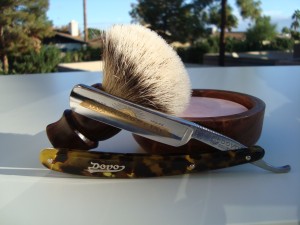
Buying a straight razor is difficult. Unlike purchasing a modern cartridge razor, there are options within options. This article will focus on new straight razors only. New razors made by the likes of: Dovo, Hart Steel, Thiers Issard, Revisor, Boker, Henckels, and Wacker. If you don’t see Fromm or Double Arrow on the list, it’s for a reason.
This article is broken into two parts. The first part is for the man who has never owned a straight razor before. The second half of the article is a guide for buying a razor (either for yourself or someone else) for the man who is a veteran at straight razor shaving.
Anatomy of a Straight Razor
For you veterans, you already know all these terms. For beginner’s, these are the terms of the trade. I will be using them to reference the various parts and features of various straight razors. Please reference these photos for straight razor terms.
Straight Razor Parts | Straight Razor Points | Straight Razor Grinds
Buy Shave Ready
When looking to purchase your first straight razor, there is one thing that is universally needed: a shave ready razor. Anything less than a shave ready razor will mean your first experience with a straight razor will be either sub-par or end in disaster. A razor needs to be not only sharp enough to cut beard hair, but it also needs to be sharp enough and smooth enough to cut cleanly without pulling. Think of your disposable razor if you want an example of a razor sharp enough to shave, but causes a lot of irritation through pulling.
Only Buy Razors Advertised as Shave Ready
With teh re-emergence of the straight razor as an artisan method of shaving, many vendors offer shave ready straight razors. Beware razors not offered as shave ready because they only come with a factory edge. While some manufacturers put a decent enough edge on their razors, it isn’t nearly the same level of sharpness as from a qualified honemeister.
Razor Width/Size
Razor width is the only real decision you have to make. The razor’s width will affect how easy it is to handle, the heft of the blade, and will narrow your options. As a beginner, you should buy no larger than 6/8″. 5/8″ is the most commonly recommended width, although 4/8″ has its advantages (but since no one makes any its not really in the running).
ASR recommends a 5/8″ razor for your first straight.
The reason we recommend a 5/8″ razor over a 6/8″ and absolutely recommend against anything larger, is because of ease of control. A smaller blade is vastly more maneuverable than a larger blade. While a larger blade allows you to see the angle of the razor a little easier, that isn’t a huge concern. Control over the razor is your first and only concern when starting out. Using a straight razor is a learned skill, you can’t pick one up and expect to master it in the first shave. The smaller the blade, the lighter it is and the easier it is to move around your face. In addition, it won’t get as stuck on your nose.
Manufacturer
If your purchasing a new razor, you are limited in your choice as to who will make your razor. The major makers are Dovo and Thiers Issard followed by Boker, Revisor, Wacker, and Hart. Giesen & Forsoff and Gold Dollar also make razors but don’t have a huge presence in the market.
Yet another option is the custom or semi custom market. Beginners are well advised to stay away from these razors because you should know exactly what you want before plopping down the premium for a unique creation.
The Point
First, you need to have a basic idea of what you are looking for. Let’s talk about the tip/point first. As a beginner it is highly recommended to stay away from square or spike tips because of the pointy edge. Many a new user and veteran has inadvertently gouged themselves with the spiked point. Every other point has a rounded edge at the tip making it much harder to stab yourself with. That said, you can always ask your razor sharpener to mellow the spike by honing the spike off.
When purchasing your first razor, the reality of the situation is that your choice is going to be limited by budget and aesthetic concerns.
As for which point is best for a beginner, it comes down to aesthetic preference. None of the designs offers any functionality over any others with the exception of the spike point, whose sharp point is great for detail work. Just purchase the razor whose point looks the best to you. Between Dovo, Thiers Issard, Boker, and Wacker you should be able to find the point you want.
The Grind
Nearly all new straight razors are hollow ground. None are wedge ground anymore (and for good reason). To get a wedge or 1/4 hollow, you will have to go the custom route. Some razors are ground 1/2 or 3/4 hollow, such as the Thiers Issard Le Grelot or the Hart razor. Aesthetically, there is very little difference between hollow and half hollow. Quarter hollow will look a little more wedge-like, but those aren’t mass produced anymore.
The grind is the last thing you should worry about when purchasing your first razor. Nearly all new razors are hollow, so there is no real choice in the matter unless you go custom.
New users should stick with a hollow grind. They are easier to manuever around your face and a lot easier to hone. The only advantage thicker grinds offer is more mass behind the razor. Men with thicker beards report that the extra mass makes it easier to get through their tough beards. Of course, you can replicate the ease of cutting by applying more force while shaving.
Jimps/Thumb Notches
Jimps are little indentations cut into the tang of the razor for better grip. If you can afford a razor with jimps, you should buy one with jimps. They offer a better grip on the razor for easier control. Most razors with jimps come with bottom jimps. Some come with top jimps. Having both means a better grip on the razor.
Jimps are highly recommended. A thumb notch is like a warm cradle for your thumb. Having both is true shaving luxury.
A thumb notch is just that. A concave notch cut into the tang for your thumb. Can be combined with jimps. A great example of both is the Thiers Issard Oak Wing. Thumb notches don’t allow for greater control, but do make a great resting place for your thumb. Plus its comfortable.
The Steel
Dovo and Thiers Issard have come out with models advertising Silver Steel or some other exotic sounding name. The truth is that with modern steel, it doesn’t matter. Modern steel is so uniform and well made that the the true difference is going to come down to the heat treatment. See our related article on what makes a razor sharp.
In terms of whether you should buy these supposedly better steels, the answer is yes. If the razor otherwise appeals to you, you should buy it. Another consideration is that these razors generally have a better level of fit and finish and thus perform slightly better according to some accounts. In the end, it’s just marketing, but usually denotes a higher end model.
Scales, Etching, etc.
There is a huge variety of scale materials to choose from. From wood to bone to plastic, they all do the same job of protecting the edge while the razor is not in use. Plastic comes in many designs, from the very plain white or black, to the iconic Dovo faux Tortoiseshell. Wood provides that unique and natural look to the straight razor, while man made materials such as Micarta offer a modern, yet refined look. Horn and bone are the most traditional choices. There are many more scale materials than I can write about in this section. The only consideration you have to make is whether you like the look of the scales on the razor.
Most modern razors come with balanced scales, but some scales are extremely heavy relative to the blade. Specifically the Dovo Mammoth Ivory and the Dovo Micarta scales. These scales are much heavier than their respective blades and throw off the balance. But they sure do look great.
Scales, spine work, and blade etching are purely aesthetic considerations. Purchase the razor you like the look of.
The same considerations go into the gold wash or etching on the blade. From the extremely simple Dovo Best to the intricate and beautiful Bergischer Lowe, there is a wide range of options. Again, for spine work. A worked spine such as that found on the Bergischer Lowe simply add to the complexity and beauty of the straight razor. Such added details also add to the cost.
How Much to Spend
The last major factor this article will touch upon is the cost. The amount of money you spend on a straight razor should fit your budget. That said, a straight razor is an investment which will pay off in the long run with incredible savings over time. However, if your only looking to try straight razor shaving, you should only buy a basic razor.
If you are sure your going to stick with straight razor shaving no matter what, buy the razor that you really want. Don’t go into debt to buy it though, they don’t cost that much.
If you aren’t sure about straight razor shaving, buy the razor that fits your budget and that you wouldn’t mind keeping for a long time. The great thing about straight razors is that they hold their value extremely well. They’re not art, but you can expect to be able to recoup ~75% of the lowest retail price.
If you just want to try straight razor shaving, your better off finding a friend to borrow one from. Otherwise, a Dovo “Best Quality” is the cheapest new straight razor you can easily find shave ready. Another option is to check out the offerings at Razor Emporium to see if there are any restored vintage razors within your price range.
Razors to Avoid
With so many sellers trying to get your money for nothing, you have to watch out for yourself and take precautions. As said earlier, only buy a shave ready razor. If the razor is not sold as shave ready, unless you want it solely for your mantlepiece, look for another vendor or count on spending an additional $20 for honing.
Avoid anything made in Pakistan. Period. This cannot be stressed enough. No matter how pretty it looks, don’t buy it.
Avoid the following razors: Timor, Fromm, & Venus. In fact, avoid any razors that claim to be made in Germany and costs less than a Dovo Best. We’re not entirely sure where these razors are made, but other countries’ made in standards are less stringent than the US’s. All you need to know about these razors is that they’re mediocre at best, don’t come shave ready, and are so close in price to a Dovo Best, your better off buying one of those.

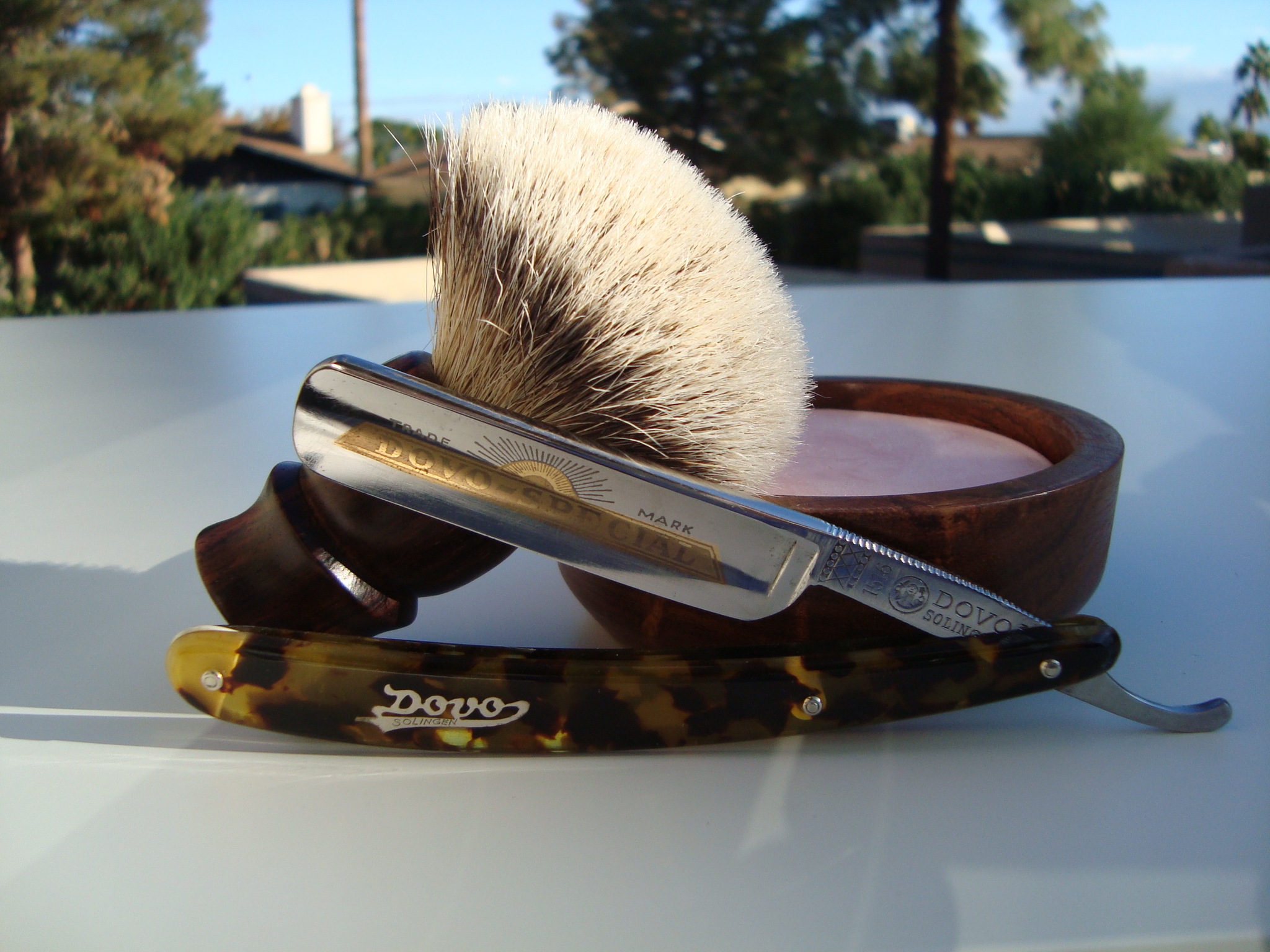
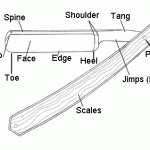
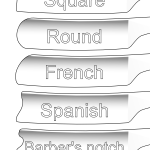
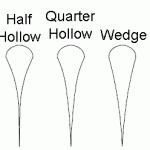
Hi Lee,
Thank you for your well-written articles. After using a shavette, I am ready for a straight razor. You have recommended a 5/8″ razor, and I have also read that a half hollow is better to start with that a full hollow. The GD razors have gotten good reviews from you, but some of the specs are not clear. Please let me know if you would recommend one of these as a first razor, or if you would suggest something else.
Thank you,
Ray
The Gold Dollars don’t make a good heirloom piece, but then again, neither does a Dovo Best unless you rescale it. The Gold Dollars are fully functional, but lack in aesthetics. Unless you’re leaning towards a smaller razor (4/8″), then a Gold Dollar is a good workhorse and an affordable entry into the straight razor field. Also, if you rust it or trash it, you can buy 3 for the price of one Dovo Best.